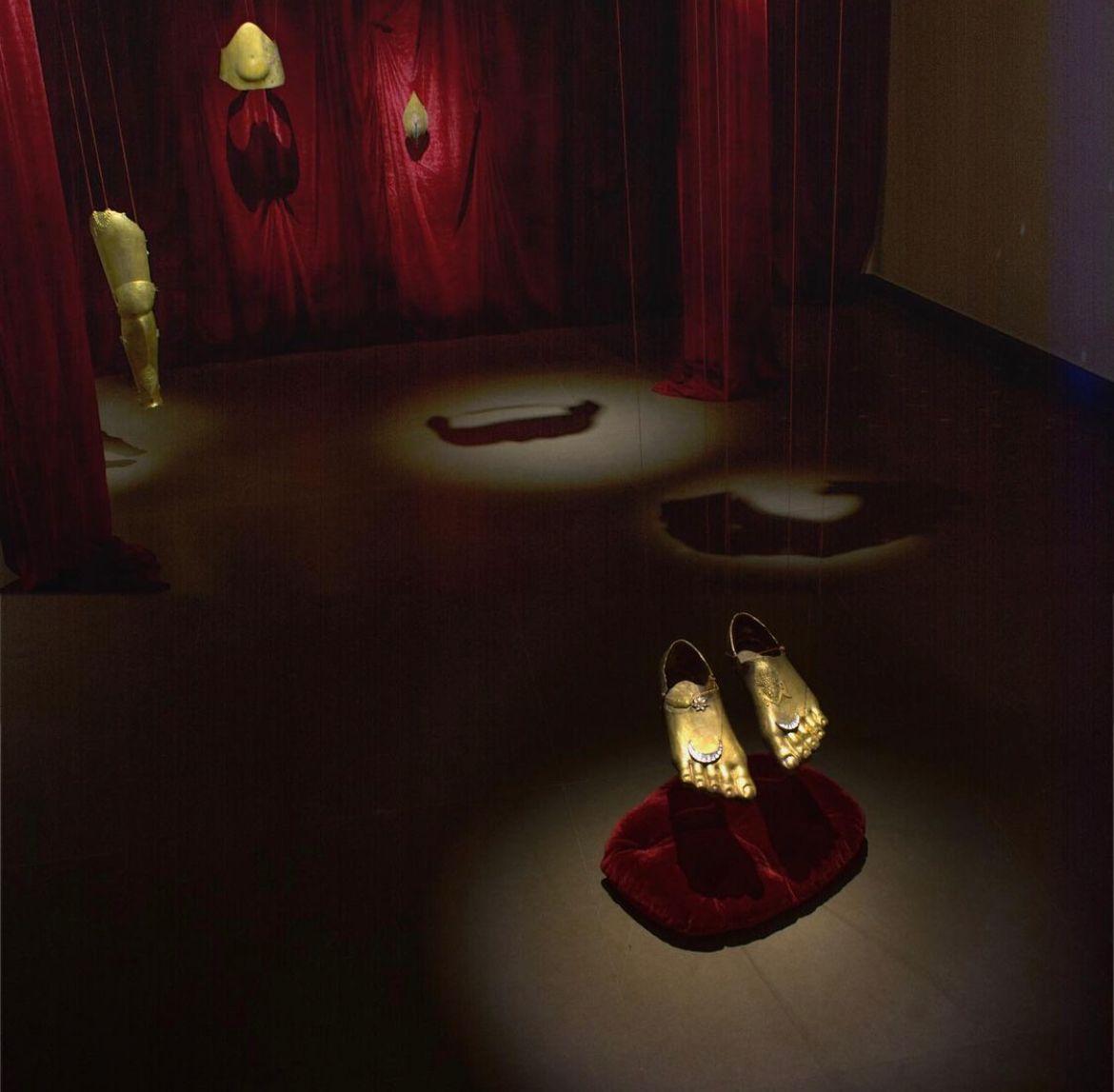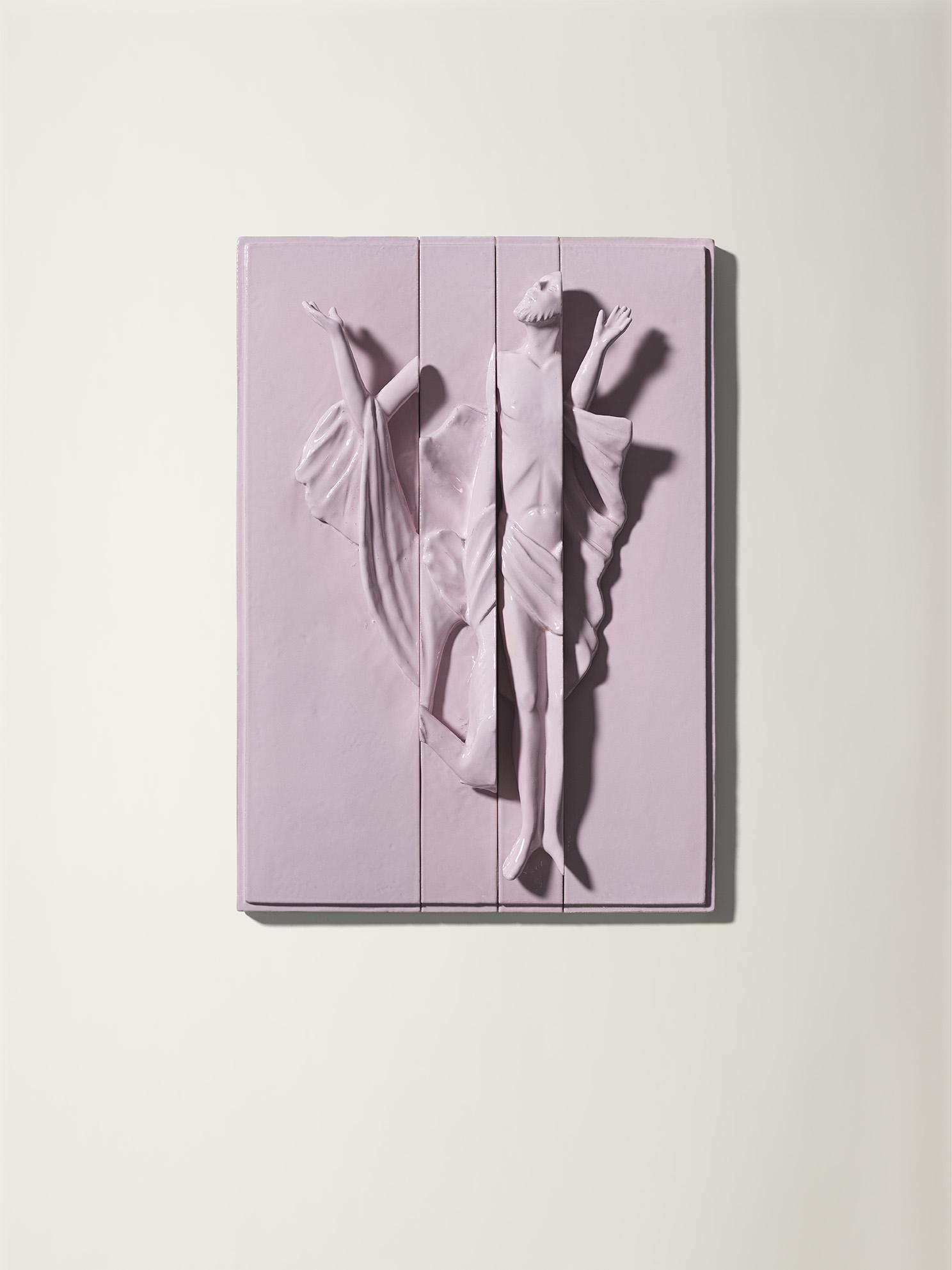Transformations in Cross-Cultural Art: In Conversation with Myna Mukherjee and Davide Quadrio
The exhibition Vita Nova, organised at and produced by the Italian Embassy Cultural Center in New Delhi in 2022, explored contemporary craft and art from Italy and India in terms of transformations, connections and departures. Curated by Myna Mukherjee and Davide Quadrio, the exhibition recalled Dante’s text of the same name and presented the works of six artists from Italy and India, who explored the idea of transformative life that the poet wrote about, while working with different craft traditions. We discussed various topics with the curators, including the process of germination of the ideas behind the exhibition, craft as a way of understanding contemporary conversations around gender and identity politics, ecology and sustainability, and extending beyond the limited format of the exhibition through engagement with different media.

Installation view of Vita Nova at the Italian Embassy Cultural Center in New Delhi, 2022.
Sucheta Chakraborty (SC): Tell us about the inspiration behind the exhibition, the decision to choose Dante’s literature as a starting point and the initial conversation around it.
Myna Mukherjee (MM): We started with an exhibition three years back called Visions in the Making, where the idea was to explore artists from Italy and India to examine shared cultural points and divergences. It was a successful show, but we realised that a studied engagement would yield more satisfying experiments. That led to our first collaboration. We realised that there were more similarities (rather than differences) in art practices across Italy and India, possibly because both countries have cultures that are contemporary, and yet rooted in tradition.
We did an exhibition called Hub India which explored mythology and looked at the diversity of art practices across the subcontinent, and that got us excited about the possibility of artists working with craft traditions rooted in the past but seeing newer manifestations, and that conversation is happening in both India and Italy. The year 2021 marked Dante’s seven hundredth death anniversary, and a lot of the artists were exploring the idea of transformation, and hence Dante’s hybridity and resonance with nature became a joined theme.

Into The Metaverse I, 2022. Acrylic on canvas with mineral paints. 48 x 72in. Raghava KK and Miniature Artists from Jaipur
SC: How did each of the artists interpret Dante, both in terms of material as well as meaning?
MM: Many of the artists explored the idea of a hybrid character between the animal form and the human form. Raghava KK had a two-headed tiger as a metaphor for polarities within a single person but also referenced Tipu’s Tiger. It was both a sculpture and a musical instrument, employing handcrafted traditions like puppeteering from Rajasthan with carved wood and lohar techniques of hand-beaten brass. Puneet Kaushik’s work also brought out his explorations of his own being fused with animals, [reminiscent also of] Dante’s creatures of the forest, through bidri work, blue pottery from Jaipur and canvases like carpets, where he has worked with Ajrak, block printing, carpet weaving and tufting. Shilo Shiv Suleman worked with beaten copper and explored the idea of the forest as a space of myth and magic.

From 'Picking Up Pieces of Myself', 2021. Brass and Precious stones. Consisting 20 organs. Shilo Shiv Suleman.
Davide Quadrio (DQ): The three Italian artists were chosen because they engaged with Dante on one side, and cross-cultural craftsmanship and industrial design on the other. Marta Roberti recreated the imaginary around manhood in Dante’s work, and transformed it into a female world. There is a critical approach to masculinity in her work, with commentaries on Dante’s take on The Divine Comedy and the passage through life and death from a female point of view, and the idea was to work with kari embroidery from Kashmir. We also presented some of Francesco Simeti’s rarer works which were wooden prints that look like natural landscapes, presented in relation to the forest with which Dante starts The Divine Comedy. It also talks about the contemporary world, because these are landscapes connected to devastation created by human beings. We like this idea of having illustrations which are put in relation to the written word and work of Dante, but they are in fact commentaries on humanity and [the impact] of our activities on the planet. The third is Andrea Anastasio, who has been in India for many years and has been attracted to the tension between art and the industrial. He works with found objects and interacts with the historical and political layers that these kinds of artefacts imply. Some of his work become quite complicated to read because of this presence of the industrial taste. He represents what post-war industrial design and art has been doing in Italy, which is not only functional but also carries a philosophical point of view.

Pale Pink Chirst, 2018. Glazed Ceramic, metal frame. 39x54cm. Andrea Anastasio.
SC: Could you elaborate a little more on how the works have used craft as a position for understanding contemporary political and aesthetic issues?
MM: This exhibition was proposed as a conceptual process of object-making and transformation, with the artist placed firmly at the helm of their production. For example, Shilo Shiv Suleman’s work explores identity politics and material expressions of personal and cultural narratives. She has this piece with beautiful parts of the female form crafted through hand-beaten copper that is about the shakti peeths and the whole myth of Shiva carrying Sati’s body around after she self-immolated herself, with parts of the body falling in different parts of the world. The piece talks about the strength of the female anatomy, and what a point of reverence that is, and yet is seen so differently in the world today. In the same way, Marta Roberti’s work is a smart, feminist re-appropriation of academical and art historical works of masculinity. Andrea’s work is a comment on industrialisation and what has been lost through rapid urbanisation, but it also brings the attention back to the handcrafted…
DQ: Yeah, which is also something that is anthropologically connecting everybody today. There are these underlined alphabets which are not about differences but commonalities and sharing.
Temecula, 2008 - 2011. Woodcut (black). 38.18x50in. Francesco Simeti.
SC: Are there plans of taking forward some of the ideas that the exhibition has thrown up and investigating them through other ventures in the future?
MM: That’s a great question, and it’s a constant search for us. We started collaborating with an exhibition that was about three Italian and three Indian artists, but that brought up many questions of cross-cultural reflection, like what is truly cross-cultural in today’s world and what avoids the pitfall of a colonialist look. Some of those thoughts took us forward to Hub India, and then we ended up creating a film (SAMA: Symbols and Gestures in Contemporary Art of Italy and India) that explored art practices between the two countries. While travelling through Italy and India for it, we realised what a strong connect craft has in the imagination of art practices for contemporary artists in the two countries, and that was really the germination point for this particular exhibition.
DQ: What we undertook in the last year and a half implies an incredible strength, not only of the individual but also in the relationship that we’ve been able to build together with Myna in the last three years. It is not about making closed exhibitions but exploring possibilities and also exploring how limited the format of the exhibition is, and the film is an outcome of this consideration. Because it is not about the audiences of the exhibitions, but it is going further than that and lending a stronger voice to what we do through different kinds of media and distribution. The same frustration that we experienced over the Covid years was also an incredible exercise [in understanding] what it really means to work in cross-cultural environments, and the respect and strength that it requires.
1.jpg)
"Se Io Mi Intuassi Come Tu Ti Inmii : La Ladra e Il Serpente." Inferno, Canto XXIV, Versi 79-151, 2021. Fabric Cotton, Embroidery Cotton/Viscose blend. 73” x 67in. Marta Roberti.
Also read Sucheta Chakraborty’s interview with Jiten Thukral on using the medium of games and book-making in their recent works.
All images courtesy of the artists and the Italian Embassy Cultural Centre, unless mentioned otherwise.




